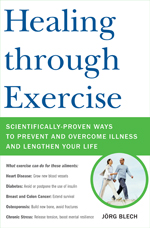
News flash: exercise is good for you.
Sure, we all know it.
But do you know why?
And do you know the many hows? Judging from a lot of traditional medical advice, most folks have failed to appreciate the plethora of ways in which exercise can treat, heal, and even cure. Bed rest is commonly prescribed, particularly for older people. Yet according to Blech, this is likely the worst advice someone can receive!
The book opens with an apt quote from philosopher Blaise Pascal: “Our nature consists in motion; complete rest is death.” This is, essentially, Blech’s foundational premise.
He’s concerned that although the therapeutic value of exercise is well-known in clinical and exercise physiology circles, this insight hasn’t trickled down to the general consciousness as well as it should. As a result, “patients and physicians alike far too often try to fix medical problems with drugs, high-technology procedures, and simply resting in bed.”
Indeed, the market for pharmaceuticals is ever-increasing. But do we need many of these costly and potentially dangerous therapies, and should their use be so widespread — especially when a potent treatment is as close as our front door, and as complicated as putting on a pair of walking shoes?
Blech reviews a variety of common health conditions such as cancer, diabetes, heart disease, and back pain along with aging in order to demonstrate (with well researched sources) that exercise offers profound benefits in treating and preventing many of the chronic diseases that plague us.
For example, breast, colon, and prostate cancer levels are lower in active people. The beneficial effects of exercise in this case are due to lowered body fat (which decreases the amount of chemical secretions that may stimulate cancer growth), enhanced immune systems, and lowered levels of stress (which again can produce high levels of damaging hormones and chemicals). For people with cancer and other chronic diseases, exercise drastically improves quality of life.
Aging is often viewed as an inevitable shuffle towards decreptitude and decay. And yet, says Blech, much of what we expect as “normal” aging is simply disuse. We don’t have to accept a slower pace, dissolving muscle tissue, falling down, and chronic pain as just part of getting older. Indeed, he says, we should not accept it. Exercise keeps us young, keeps older folks vigorous, and lengthens our lives overall.
One of the more interesting topics is the relationship between mental wellbeing and exercise. Blech describes a psychiatrist who combines therapy with exercise sessions, interacting with patients while they both walk on treadmills.
Such a practice has roots in the “walking meditations” of monks. The intricate Celtic mazes were often used as paths for monks to follow as they engaged in spiritual deliberation, but the practice is common to devotees worldwide.
Indeed, the common assumption that the mind cannot influence the body — and, indeed, is an entirely separate entity from it, like a smart little driver perched atop a big, stupid car, is now heavily questioned. “The body builds the mind as well as itself,” states Blech. “If you exercise your muscles, you practically flood your gray cells with fresh nutrients and growth factors.”
While it’s tempting to assume that Blech would assign us all gym memberships and have us sweat to the oldies, he is careful to point out that exercise is life — and we are not separate from it.
“Exercise” is not a special thing that we need to go elsewhere to do; we all have the potential to move around at every moment, and to incorporate it into our daily existence. Our species evolved quite well without spandex and spin classes, after all.